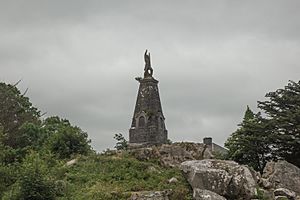Battle of Collooney facts for kids
Quick facts for kids Battle of Collooney / Carricknagat |
|||||||
|---|---|---|---|---|---|---|---|
| Part of the Irish Rebellion | |||||||
 The monument commemorating the battle. |
|||||||
|
|||||||
| Belligerents | |||||||
| Commanders and leaders | |||||||
| Jean Humbert | Sir Gerard Lake Charles Vereker |
||||||
| Strength | |||||||
| 2,000–3,000 | ~500 | ||||||
| Casualties and losses | |||||||
| 10 dead | 120 dead, 100 captured | ||||||
The Battle of Collooney, also known as the Battle of Carricknagat, was an important fight during the Irish Rebellion of 1798. It happened on September 5, 1798. In this battle, a group of French soldiers and Irish rebels worked together. They fought against British troops near Collooney, a town close to Sligo Town. The French and Irish forces won this battle.
Contents
Why Did the Battle of Collooney Happen?
French Help for the Irish Rebellion
The Irish rebels had been hoping for help from France for a long time. Finally, on August 22, 1798, about 1,100 French soldiers arrived. They landed at Kilcummin Strand in County Mayo. This spot was far away from where most British soldiers were. The British were busy in the east of Ireland, dealing with other rebel groups.
Because the landing was in a quiet area, the French faced no resistance. They quickly took over the nearby town of Killala. Local yeomen (volunteer soldiers) tried to stop them but failed. Two days later, the French and Irish also captured Ballina. More Irish volunteers joined the French army as news of their arrival spread.
Humbert's March Towards Ulster
A French general named Jean Joseph Amable Humbert led these forces. He had won a big victory at Castlebar. This win brought about 5,000 new Irish recruits to his side. However, the rebellion did not spread as much as he had hoped.
The British gathered a large army of about 26,000 soldiers. This army was led by Lord Cornwallis, who was the new leader of Ireland. Lord Cornwallis's army was moving closer to Humbert's forces. So, General Humbert decided to leave Castlebar. He planned to march towards Ulster through Sligo. He hoped to start a new uprising there.
What Happened During the Battle?
The March to Collooney
The French and Irish soldiers marched northeast. Their goal was to reach Sligo and then continue to County Donegal in Ulster. When they arrived at the village of Collooney, they met British troops. These British soldiers were from the garrison in Sligo, which was about five miles north.
A small fight began at Carricknagat. This is a tiny area just north of Collooney. That's why the battle is also called the Battle of Carricknagat.
The Fight at Union Rock
On September 5, 1798, the French and Irish troops pushed north through County Sligo. But they were stopped by a British cannon. The British had placed this cannon high up on Union Rock, near Collooney.
A brave young Irish helper to General Humbert, Lieutenant Bartholomew Teeling, showed great courage. Teeling rode ahead of the French army all by himself. He galloped towards the British cannon position on Union Rock. He had a pistol and shot the British gunner. Then he captured the cannon.
After losing their cannon, the British forces retreated. They went back towards their barracks in Sligo. The French and Irish army advanced. The British left behind 120 dead soldiers and 100 prisoners.
Aftermath of the Battle
Colonel Charles Vereker led the Limerick militia during this battle. He was given a special honor called a "peerage" for his actions. This meant he became a lord.
Teeling Monument
In 1898, a hundred years after the battle, a statue of Bartholomew Teeling was put up in Carricknagat. This monument honors his bravery during the battle.

